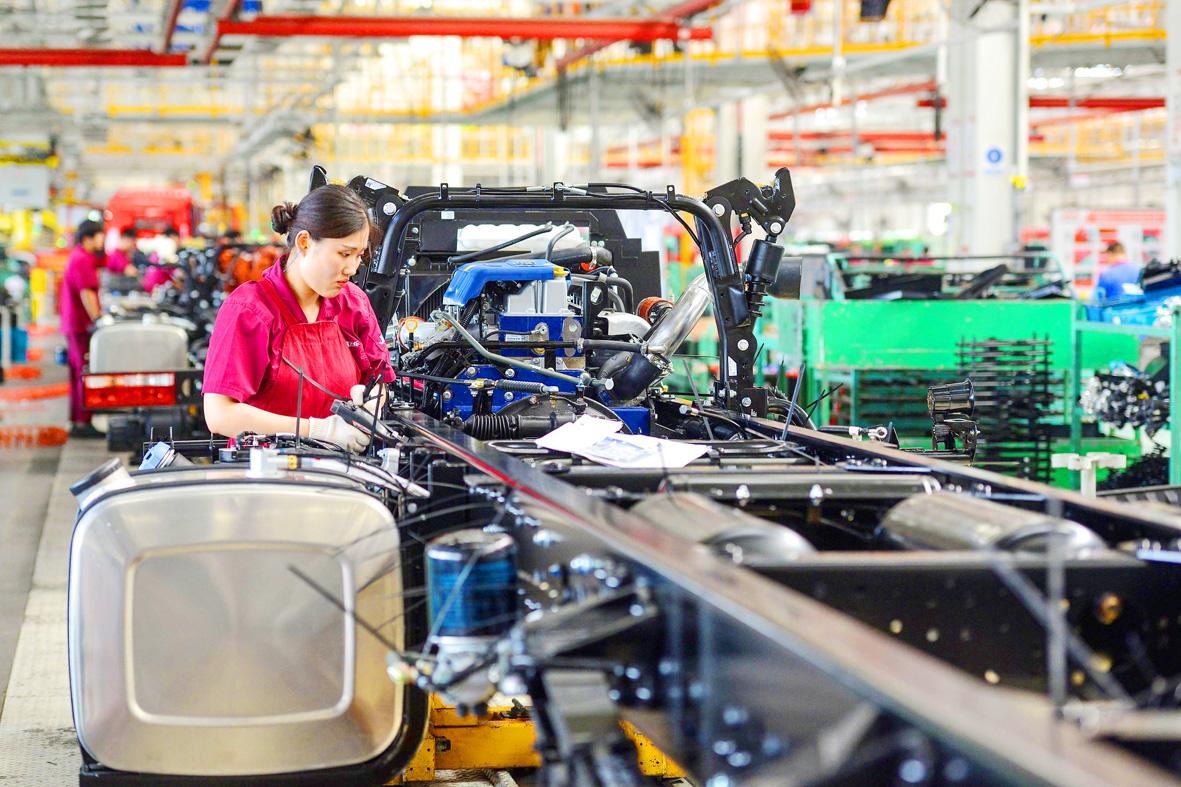China saw forecast-beating economic growth in the second quarter after a record contraction in the previous three months, as businesses cautiously returned to normality following lockdowns due to the COVID-19 pandemic.
The figures released yesterday follow a string of data showing the world’s No. 2 economy slowly emerging from the outbreak and should provide hope to other governments looking to get back on track.
GDP expanded 3.2 percent in the April-to-June period, the Chinese National Bureau of Statistics said, smashing expectations and a massive improvement on the 6.8 percent contraction in the first quarter.

Photo: AFP
However, in a sign that full recovery could take time, retail sales — a key indicator of consumer sentiment in China — fell short of forecasts, shrinking 1.8 percent year-on-year last month.
That suggests people remain reticent about going out to spend even as the virus appears largely under control in China.
The retail sector has taken on an increasingly crucial role in China’s economy as leaders look for consumers, rather than trade and investment, to drive growth.
There is an even greater need for a pickup in domestic consumption as China’s external demand weakens, but it is easier to normalize supply than demand, AxiCorp strategist Stephen Innes said.
Louis Kuijs of Oxford Economics said that household consumption remains the “weakest link” among indicators, although China’s economic upturn is expected to continue in the second half of this year.
Economists warn of uncertainty ahead owing to an uneven recovery — growth in infrastructure investment has rebounded, but private fixed-asset investment and retail sales remained weak.
Last quarter’s growth reading, while beating the 1.3 percent growth tipped in an Agence France-Presse poll of analysts, is still among China’s lowest quarterly growth rates on record.
The economy contracted 1.6 percent year-on-year in the first six months, the bureau said, while the urban unemployment rate dipped to 5.7 percent last month, from 5.9 percent a month earlier.
Unemployment is a closely watched marker, with nearly 9 million graduates expected to enter an uncertain labor market this year and analysts saying the actual jobless rate is likely higher, especially when the huge floating population of migrant workers is taken into account.
Industrial production grew 4.8 percent last month, in line with expectations and up from 4.4 percent in May.
Bureau spokeswoman Liu Aihua (劉愛華) told a news conference that China’s economy “demonstrated a momentum of restorative growth and gradual recovery.”
However, with the pandemic still ravaging many of China’s key trading partners, national economic recovery was “still under pressure,” Liu said.
China is expected to be the only major economy to see growth this year, being the first hit by the virus and to bounce back. However, economists warn that official Chinese economic figures should be taken with a grain of salt, with longstanding suspicions that growth data are massaged upward for political reasons by the Chinese Communist Party, which has based its legitimacy on delivering continued prosperity.
“Is it too good to be true?” ING Bank NV chief economist for Greater China Iris Pang (彭藹嬈) asked, adding that more data were needed.
She also pointed to risks down the road, including trade and tech tensions with other major economies, and major flooding in parts of China.

Zhang Yazhou was sitting in the passenger seat of her Tesla Model 3 when she said she heard her father’s panicked voice: The brakes do not work. Approaching a red light, her father swerved around two cars before plowing into a sport utility vehicle and a sedan, and crashing into a large concrete barrier. Stunned, Zhang gazed at the deflating airbag in front of her. She could never have imagined what was to come: Tesla Inc sued her for defamation for complaining publicly about the vehicles brakes — and won. A Chinese court ordered Zhang to pay more than US$23,000 in

Taiwan Semiconductor Manufacturing Co (TSMC, 台積電) yesterday said that its investment plan in Arizona is going according to schedule, following a local media report claiming that the company is planning to break ground on its third wafer fab in the US in June. In a statement, TSMC said it does not comment on market speculation, but that its investments in Arizona are proceeding well. TSMC is investing more than US$65 billion in Arizona to build three advanced wafer fabs. The first one has started production using the 4-nanometer (nm) process, while the second one would start mass production using the

US President Donald Trump has threatened to impose up to 100 percent tariffs on Taiwan’s semiconductor exports to the US to encourage chip manufacturers to move their production facilities to the US, but experts are questioning his strategy, warning it could harm industries on both sides. “I’m very confused and surprised that the Trump administration would try and do this,” Bob O’Donnell, chief analyst and founder of TECHnalysis Research in California, said in an interview with the Central News Agency on Wednesday. “It seems to reflect the fact that they don’t understand how the semiconductor industry really works,” O’Donnell said. Economic sanctions would

‘NO DISRUPTION’: A US trade association said that it was ready to work with the US administration to streamline the program’s requirements and achieve shared goals The White House is seeking to renegotiate US CHIPS and Science Act awards and has signaled delays to some upcoming semiconductor disbursements, two sources familiar with the matter told reporters. The people, along with a third source, said that the new US administration is reviewing the projects awarded under the 2022 law, meant to boost US domestic semiconductor output with US$39 billion in subsidies. Washington plans to renegotiate some of the deals after assessing and changing current requirements, the sources said. The extent of the possible changes and how they would affect agreements already finalized was not immediately clear. It was not known